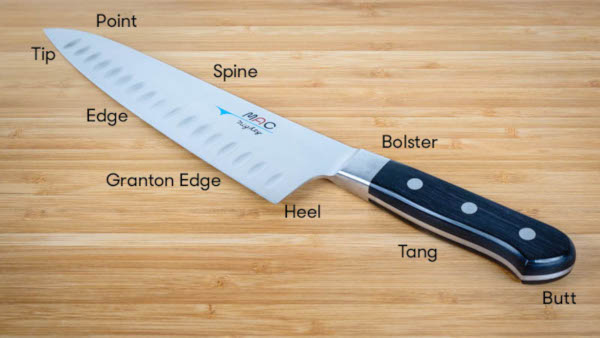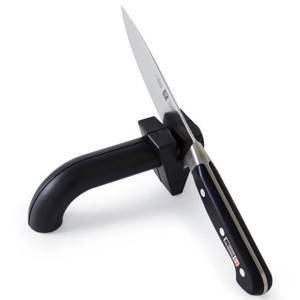Good knife skills are at the heart of every culinary endeavour. And at the heart of good knife practice is… a good blade! You can never become a great cook if you use cheap knives that don’t hold their edge or flex too easily when you’re trying to make precise, straight cuts…
 Every serious cook should know the parts of a principle kitchen knife.
Every serious cook should know the parts of a principle kitchen knife.
Note the riveted wooden handle forged construction and
clefts, or ‘fullers’ just above the edge…
The most important part of achieving good knife skills is to make friends with a good knife. It’s going to be your best friend in the kitchen, no matter what you’re preparing…
Choose the right knife…
Up to about a decade ago, the average cook had one choice of primary blade: the classic French Chef’s Knife. Now, you can choose from a variety of blade profiles thanks to the introduction of Asian coking styles into western kitchens. I posted about the various common knife types in my Cooking 101 series a few years back. Whatever knife you choose to be your best friend in the kitchen, you should consider the following general guidelines:
Your primary, all-purpose knife should have at least an 8 in. / 20 cm long blade. This will let you deal comfortably with most common food items over a wide range of sizes. But I also have a 10 in. / 25 cm blade which comes in very handy when dealing with large heads of Cabbage or Lettuce, or parsing tough stuff like Turnips or other obstinate root veggies.
I prefer the standard French Chef blade shape because that’s what I’ve always used. But many household and even to cooks these days are going for the so-called Santoku blade, which features a modest curve on the bottom edge and an ‘eagle’s beak’ down-turned point. The flatter profile of the cutting edge is definitely a plus in many applications.
Your knives should balance exactly at the point where you hold then, right at the heel. Ideally, you should simply guide the blade and let the knife do the work.
I also have a Boning Knife with a thin sharp blade for removing the bones from various meats, deconstructing poultry, and other such tasks. if you work with meats a lot, you should have one. And its thin blade makes the Boning Knife a dream for filleting and skinning Fish!
Do pay extra for a better-quality knife – one that’s forged, not simply stamped from a sheet of steel. You’ll get a stronger blade made of better-quality metal that will last longer and keep an edge longer. And, in the long run, you’ll be a happier, more accomplished cook!
Accessory blades…
At culinary school, they insisted we also have a paring knife with a 3.5 – 4 in. / 8.5 – 10 cm blade for fine work. We were also told to buy a long-bladed serrated knife. Sometimes called a Bread Knife, it’s useful for many other tasks involving tough or frozen foods, too. From there, you can add as many specialty blades as you wish, depending on your cro0ss-cultural and artistic cooking interests.
Food Processors…
Pretty much every kitchen where serious cooks operate has a Food Processor these days.These mechanical marvels make short work of formerly tedious tasks such as slicing, dicing, chopping, grating, shredding, mincing and puréeing. If time is a precious resource in your lifestyle, and you still want to cook for yourself and your family rather than relying on heavily processed, convenience foods or take-out, a good quality Food Processor may be just the ticket for you.If you intend to sub-out common knife operations to a food processor, invest in a good quality unit by a reliable maker, with a heavy die-cast base for stability and a powerful motor – at least 1,000 watts – to ensure it will do everything you want it to to do and be around for the long haul. It may cost you a two or three hundred dollars, but remember: you’ll make the investment back over a couple of years because it’s always cheaper to make your own food rather than order meals in.
But you should still practice your knife skills any chance you get – on weekends, holidays or days off. You’ll be glad you did!
Caring for your knives…
If you’re making an investment in good knives, you should also resolve to take proper care of them. If you do, they’ll last you a lifetime.
What next?
In coming posts, we’ll take a closer look at the proper way to perform the most common knife operations… Don’t worry! It’s easier than you think!
~ Maggie J.

